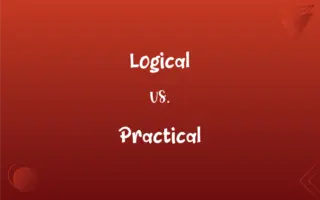Lay-off vs. Retrenchment: What's the Difference?
Edited by Harlon Moss || By Janet White || Published on November 29, 2023
Lay-off is a temporary suspension or permanent termination of employment, while retrenchment is a permanent dismissal due to business downsizing or closure.

Key Differences
A lay-off typically refers to the temporary suspension of employment, often due to economic downturns, where employees might be rehired later. Retrenchment, however, implies a permanent dismissal of employees as part of reducing business scale or shutting down operations permanently.
Lay-offs can occur when a company faces short-term financial difficulties or seasonal fluctuations, with the intention of recalling employees when conditions improve. While, retrenchment is a strategic decision, reflecting long-term changes like organizational restructuring or discontinuation of a business segment.
In a lay-off, employees may retain their employment relationship with the company, sometimes with benefits intact, awaiting possible reemployment. Whereas, in retrenchment, the employment relationship ends, often accompanied by a severance package, with no expectation of rejoining the company.
Lay-offs can be seen as a temporary cost-saving measure, enabling businesses to adjust to immediate financial pressures. However, retrenchment is more about long-term organizational restructuring, aligning the workforce with revised business objectives.
While lay-offs might not imply a critique of employee performance, retrenchment often results from strategic decisions to cease certain operations, indirectly related to job performance or necessity.
ADVERTISEMENT
Comparison Chart
Nature
Temporary or permanent employment suspension
Permanent dismissal
Reason
Short-term financial difficulties, seasonal changes
Long-term business restructuring, downsizing
Employment Relationship
May remain intact with possibility of return
Ends with no expectation of reemployment
Purpose
Immediate cost-saving, workforce adjustment
Aligning workforce with revised business goals
Implication for Employees
Temporary loss of job, possibly with benefits
Permanent job loss, often with severance package
ADVERTISEMENT
Lay-off and Retrenchment Definitions
Lay-off
Temporary suspension of employment due to economic reasons.
The factory workers were laid off during the off-season.
Retrenchment
Permanent termination of employment as part of company downsizing.
The retrenchment was part of the company's restructuring plan.
Lay-off
A cost-saving measure involving temporary cessation of employment.
The lay-off affected several departments in the company.
Retrenchment
A strategic move to permanently reduce workforce due to long-term changes.
The retrenchment aimed to align the workforce with new business objectives.
Lay-off
The act of temporarily dismissing employees due to lack of work.
The recent lay-offs were a result of decreased product demand.
Retrenchment
Permanent job cuts as a response to reduced business operations.
Retrenchment affected several long-term employees.
Lay-off
A temporary reduction in workforce without termination of employment.
The company announced a lay-off to cope with the economic slowdown.
Retrenchment
The process of reducing staff permanently for economic or strategic reasons.
The company's retrenchment plan was implemented over several months.
Lay-off
Suspension of employment with the possibility of future reemployment.
Many employees hoped the lay-off would be short-lived.
Retrenchment
Dismissal of employees due to business closure or restructuring.
Retrenchment followed the decision to close the manufacturing unit.
Lay-off
Alternative spelling of layoff
Retrenchment
A cutting down or back; reduction.
Retrenchment
A curtailment of expenses.
Retrenchment
The act of consolidating one's strength, as for further efforts.
Retrenchment
A curtailment or reduction.
Retrenchment
(specifically) An act of reducing expenses; economizing.
Retrenchment
(specifically) An act of terminating the employment of a worker or making an employee redundant, often to reduce expenses; a layoff.
Retrenchment
A defensive work constructed within a fortification to make it more defensible by allowing defenders to retreat into and fight from it even after the enemy has taken the outer work.
Retrenchment
The act or process of retrenching; as, the retrenchment of words in a writing.
The retrenchment of my expenses will convince you that mean to replace your fortune as far as I can.
Retrenchment
A work constructed within another, to prolong the defense of the position when the enemy has gained possession of the outer work; or to protect the defenders till they can retreat or obtain terms for a capitulation.
Retrenchment
Entrenchment consisting of an additional interior fortification to prolong the defense
Retrenchment
The reduction of expenditures in order to become financial stable
FAQs
Is retrenchment a temporary measure?
No, it's a permanent action with no expectation of rehiring the affected employees.
What does retrenchment mean?
It refers to the permanent dismissal of employees, usually due to downsizing or business restructuring.
How do companies decide who to lay off?
Decisions can be based on various factors like seniority, job role necessity, or performance.
What happens to employees after retrenchment?
They often receive a severance package and must seek employment elsewhere.
What is a lay-off?
It's the temporary suspension or permanent termination of employment, often for economic reasons.
What are common reasons for lay-offs?
Economic downturns, seasonal fluctuations, and short-term financial challenges.
What leads to retrenchment?
Long-term strategic changes like business downsizing, closure, or restructuring.
How does retrenchment affect a company's structure?
It often leads to a leaner organizational structure aligned with new business goals.
What legal obligations come with retrenchment?
Companies often have to provide notice, severance pay, and follow legal guidelines.
Can laid-off employees be rehired?
Yes, laid-off employees may be rehired if the company's situation improves.
Do employees receive benefits during a lay-off?
Sometimes, they may retain certain benefits or receive temporary financial support.
Is retrenchment based on employee performance?
It's usually more about the company's strategic needs rather than individual performance.
Is retrenchment a sign of a failing company?
It can be, but it's also used by companies adapting to market changes.
Does retrenchment indicate financial trouble?
Not always; it can be a proactive step towards strategic realignment.
What support can laid-off employees seek?
Unemployment benefits, career counseling, and job search assistance.
How should companies communicate retrenchment?
Transparently and empathetically, providing clear reasons and support options.
How do lay-offs impact company culture?
They can create uncertainty and stress among remaining employees.
Can lay-offs turn into permanent job losses?
Yes, if the company's situation doesn't improve, lay-offs can become permanent.
Are there legal requirements for lay-offs?
Yes, laws in many regions require specific procedures and possibly compensation.
Can employees negotiate during a lay-off?
They may negotiate terms like severance pay or extended benefits.
About Author
Written by
Janet WhiteJanet White has been an esteemed writer and blogger for Difference Wiki. Holding a Master's degree in Science and Medical Journalism from the prestigious Boston University, she has consistently demonstrated her expertise and passion for her field. When she's not immersed in her work, Janet relishes her time exercising, delving into a good book, and cherishing moments with friends and family.
Edited by
Harlon MossHarlon is a seasoned quality moderator and accomplished content writer for Difference Wiki. An alumnus of the prestigious University of California, he earned his degree in Computer Science. Leveraging his academic background, Harlon brings a meticulous and informed perspective to his work, ensuring content accuracy and excellence.




































































